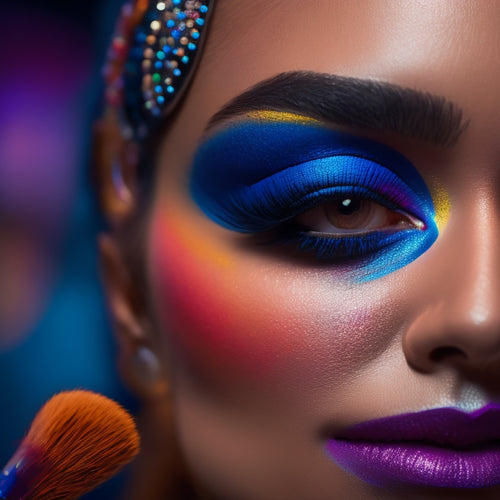
Can I Teach Myself to Tap Dance?
Share
You can teach yourself to tap dance with patience, persistence, and the right resources. Start by developing body awareness, focusing on posture, alignment, and weight distribution. Utilize online tutorials and video lessons from platforms like MasterClass and DanceWithMe to learn basic steps and rhythms. Set up a suitable practice space with a smooth floor, good sound quality, and mirrors for self-observation. As you progress, break down complex steps into smaller parts, record yourself to identify areas for improvement, and stay relaxed to develop confidence. Continue exploring and refining your technique to reveal the dynamic expression of tap dance.
Key Takeaways
• With online resources and tutorials, you can access high-quality lessons and learn at your own pace to develop your tap dance skills.
• Setting up a proper practice space with suitable flooring, good sound quality, and mirrors can help you improve your technique.
• Mastering basic tap steps like the shuffle-ball-change and focusing on clean execution and rhythmic variations can build your confidence.
• Practicing in front of a mirror, breaking down complex steps, and recording yourself can help you overcome common learning challenges like tension and improve your technique.
• Developing body awareness, posture, alignment, and weight distribution is crucial for dynamic expression and mastering tap dance movements.
Getting Started With Tap Basics
Mastering the fundamentals of tap dance begins with a solid understanding of the rich Tap History that has shaped this art form. From its African-American roots to its evolution in the jazz era, tap dance has been a dynamic expression of music and movement.
Now, it's imperative to contribute to this legacy by developing Body Awareness, focusing on your posture, alignment, and weight distribution. By standing tall, engaging your core, and relaxing your shoulders, you'll be prepared to absorb the rhythmic nuances of tap.
With each step, you'll establish a strong foundation, readying yourself for the intricate rhythms and complex steps that lie ahead.
Finding Online Resources and Tutorials
You can access a wealth of online resources and tutorials that'll help you master tap dance techniques, from beginner-friendly lessons to advanced masterclasses.
Websites like MasterClass, DanceWithMe, and Codarts offer high-quality video lessons taught by experienced instructors.
You can also join online communities, such as Facebook groups or Reddit forums, to connect with fellow tap dancers, ask questions, and learn from their experiences.
Video analysis is another valuable tool, allowing you to slow down and analyze professional tap dancers' movements frame by frame.
With online resources, you can learn at your own pace, revisit tricky steps, and perfect your technique.
Take advantage of these resources to improve your skills and stay motivated on your tap dance journey.
Setting Up Your Practice Space
Now that you've got a wealth of online resources to learn from, it's time to create a practice space that'll help you put those tap dance skills into action. A well-set-up space can make all the difference in your learning journey. Here are some essentials to ponder:
-
Flooring Options: Invest in a smooth, hardwood floor or a Marley floor that can withstand the impact of tap shoes. Avoid carpets or uneven surfaces that might hinder your movement.
-
Sound Quality: Guarantee good sound quality by placing your sound system in a way that minimizes echo and reverberation.
-
Mirrors: Install mirrors that allow you to observe your movements and correct your posture.
-
Barre or Chair: Invest in a sturdy barre or chair for support and balance exercises.
-
Good Lighting: Ensure the room is well-lit to help you see your movements clearly.
Mastering Basic Tap Steps and Rhythms
Mastering basic tap steps and rhythms requires developing muscle memory and coordination, so it's important to start with the fundamentals.
You'll want to begin with basic steps like the shuffle-ball-change and the heel-toe tap. Practice these steps in front of a mirror, focusing on proper foot placement and ankle movement.
As you become more comfortable, introduce rhythmic variations to develop your rhythmic expression. Remember to practice slowly, building up speed as your muscle memory improves.
Focus on executing each step cleanly, rather than rushing through the sequence. With consistent practice, you'll develop the muscle memory needed to master these fundamental steps, laying the groundwork for more complex rhythms and choreography.
Overcoming Common Learning Challenges
One common obstacle beginners face is the tendency to tense up, causing their feet to feel heavy and unresponsive, making it difficult to execute clean, crisp sounds. As you practice, remind yourself to relax and breathe. This will help you build confidence and manage frustration.
Here are some tips to overcome common learning challenges:
-
Practice in front of a mirror to confirm proper technique and alignment.
-
Break down complex steps into smaller, manageable parts.
-
Focus on the rhythm and let the movement follow.
-
Record yourself to identify areas for improvement.
-
Celebrate small victories to stay motivated and encouraged.
Frequently Asked Questions
Can I Learn Tap Dance at an Older Age?
As you consider learning tap dance at an older age, remember that age limitations are largely mental - seniors often benefit from increased focus, discipline, and patience, making it an ideal time to start tapping your way to fun and fitness!
Do I Need to Be a Good Dancer to Learn Tap?
You don't need to be a good dancer to learn tap; focus on building a strong rhythm foundation and developing muscle memory through consistent practice, and you'll be tapping your way to success in no time!
Will Tap Dancing Help Me Lose Weight?
As you tap your way to fitness, you'll be thrilled to know that tap dancing can help you torch calories, boosting your calorie burn and fat reduction, ultimately leading to a leaner, healthier you!
Can I Wear Sneakers Instead of Tap Shoes?
Did you know that 70% of dancers experience foot injuries? When it comes to tapping, you need Sole Support and Foot Freedom. Unfortunately, sneakers won't provide that; invest in tap shoes for best performance and injury prevention, you won't regret it!
Can I Perform in Public With No Experience?
"You're ready to shine, but remember, stage fright is normal! Manage audience expectation by setting realistic goals, and don't be too hard on yourself - your passion will shine through, even with no experience."
Related Posts
-

Jazz Dance Makeup Tutorials for Dazzling On-Stage Looks
To achieve a dazzling on-stage look for your jazz dance performance, you'll want to focus on mastering stage makeup e...
-

7 Essential Training Secrets for Dance Makeup Artists
You're about to discover the secrets to transforming your dance makeup artistry into a thriving online business, wher...
-

Dance Spectacular With Limited Seating Offer
Experience the magic of dance with Santa Barbara Festival Ballet's 'Growing Up With Dance' spectacular, featuring bre...


